|
John Franklin
|
|
|
Group: Forum Members
Posts: 132,
Visits: 264
|
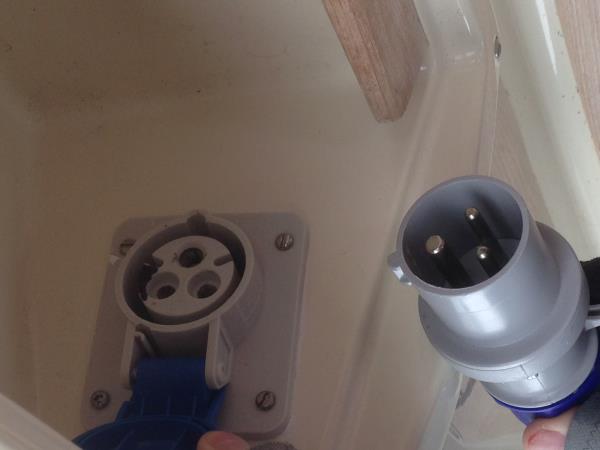 Although the photo below is upsidedown it illustrates the problem. Recently seen on a boat. The male fitting shown is on the inboard (boat) end of a shore cable connected to a marina 230 volt supply. The conductors are therefore live and consequently lethal. The appalling thing is that the non-technical owner didn't even realise the danger! It was not the installation provided by the builder but was allegedly installed by a certified electrician.
|
|
|
|
|
Dick
|
|
|
Group: Forum Members
Posts: 970,
Visits: 1.3K
|
+x Although the photo below is upsidedown it illustrates the problem.Recently seen on a boat.The male fitting shown is on the inboard (boat) end of a shore cable connected to a marina 230 volt supply. The conductors are therefore live and consequently lethal. The appalling thing is that the non-technical owner didn't even realise the danger! It was not the installation provided by the builder but was allegedly installed by a certified electrician. Hi John, So the shore power cord has 2 male plugs on it! I would take odds that no electrician did this (unless he was trying to kill the owner: which some owners do deserve.) This smells of a PO job, later attributed to a "certified electrician" to save face. Also: good always to be reminded of the kind of stupid things one can run into on a boat: and need to watch out for. Thanks for sharing. Best to Jenny, Dick Stevenson, s/v Alchemy
|
|
|
|
|
Sandy.Garrity
|
|
|
Group: Forum Members
Posts: 25,
Visits: 15
|
I've always been taught that you plug and unplug from the shore end thus never have a live cable in your hand.
|
|
|
|
|
Dick
|
|
|
Group: Forum Members
Posts: 970,
Visits: 1.3K
|
+xI've always been taught that you plug and unplug from the shore end thus never have a live cable in your hand. Hi Sandy, That sounds sensible: perhaps better is to flip the circuit breakers on the electrical pedestal (if accessible) before any disconnect either from shore or boat. Good practice indicates having all shore power needs on the boat turned off prior to unplugging, but in real life, things can be left on. Flipping the circuit breaker precludes many dangers, not least of which is a power arc when unplugging a wire still delivering power. My best, Dick Stevenson, s/v Alchemy
|
|
|
|
|
Steve Houssart
|
|
|
Group: Forum Members
Posts: 8,
Visits: 0
|
ooooh, Boat electrics I could fill this forum with these kinds of horrors I've seen over the years! same with gas installs! I'm not one in favour of stricter legislation or nanny state kind o control but it does sometimes make you wonder?
Life isn't about waiting for the storm to pass … it's about learning to dance in the rain!
|
|
|
|
|
Simon Currin
|
|
|
Group: Administrators
Posts: 1K,
Visits: 86
|
Steve, Do tell us some of the horrors. I ask with trepidation as I fear I may have committed some of my own over the years! Simon +xooooh, Boat electrics I could fill this forum with these kinds of horrors I've seen over the years! same with gas installs! I'm not one in favour of stricter legislation or nanny state kind o control but it does sometimes make you wonder?
|
|
|
|
|
Steve Houssart
|
|
|
Group: Forum Members
Posts: 8,
Visits: 0
|
+x Simon, the shore power extension lead shown in the first post on this subject is far more common than you would think Heres a few more I've found, along with seriously undersized leads, lawnmower extension leads, connector block with tape joining two leads together, wires hanging out of lazarettes with domestic 13amp connectors (quite common). 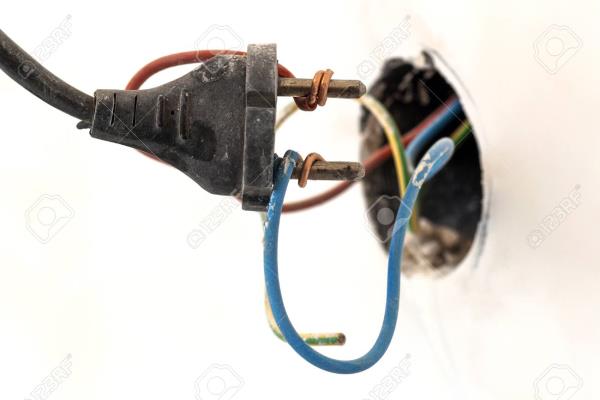 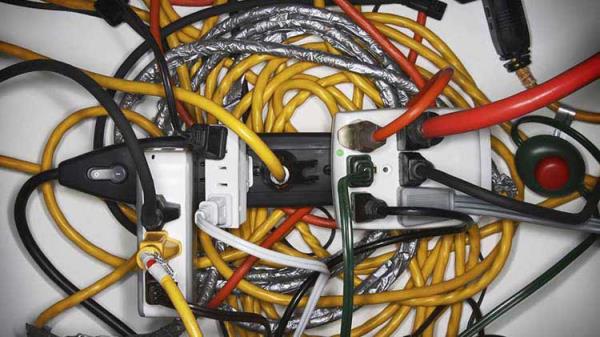 It's strange that people wouldn't except this kind of things at home but are quite happy to go to sea or sit in a marina like this? the other common fault is that people don't give there marinco plug that last twist as they insert it, this often results in a bad connection causing it to overheat, (If I had a pound for everyone one of these I've replaced for people over the years!) 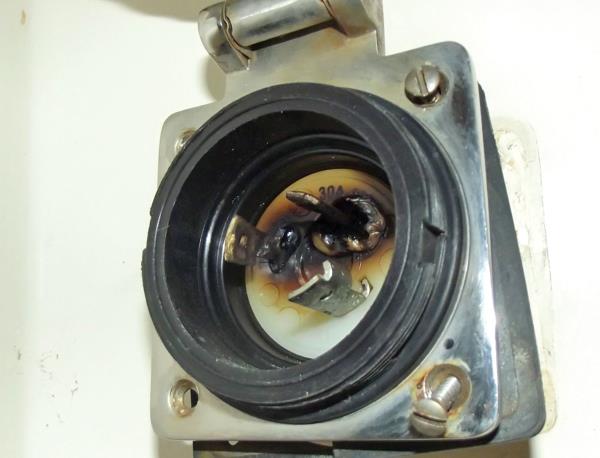 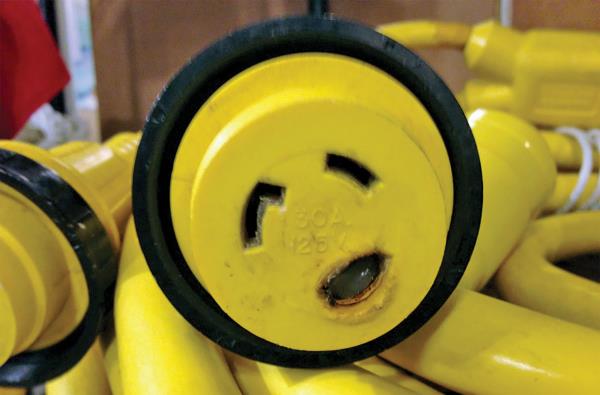 Don't even get me started on 12v circuits and the spaghetti some people call their panel wiring. I bet there's a few OCC boats like this? 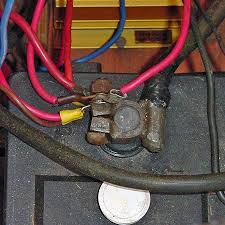 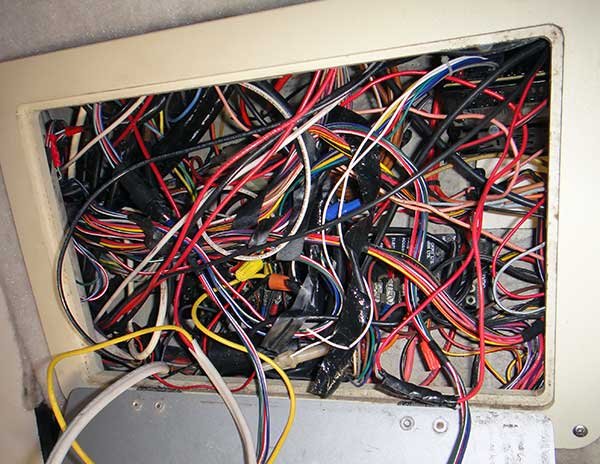 We should start a section in the main forum pages " Pictures of Safety Horrors found on boats" a prize each month for the Worst!
Life isn't about waiting for the storm to pass … it's about learning to dance in the rain!
|
|
|
|
|
Philip Heaton
|
|
|
Group: Moderators
Posts: 78,
Visits: 154
|
Some observations on this.
First, the male plug and female socket at the boat end of shore power is borderline criminal - surely the boat builder did not do this unless it was self-build.
16 months ago I plugged in our 1kw fan heater inside the boat. After a while I noticed an inappropriate smell. We have EU sockets and UK plugs so use adapters (too lazy to change the plugs) and it was the adapter working itself up into a right state, as in it was getting ready to burn the boat down. After switching off the shore power and letting things cool down, close inspection showed that the brass pins of the plug had built up a layer of crud. Cleaning with emery paper did the trick. Since then every plug gets a good dose of inspection before it goes in a socket and the plugs are now on the regular maintenance list.
The other issue is that following one of those "let's scare each other to death" cruiser conversations and given my total ignorance about matters electrical, I bought a polarity tester plug to check for reverse polarity in marinas. I also made up a plug and socket to reverse the reverse polarity - turned out that the marina where we were berthed (Albufeira, Potrugal) did indeed have reverse polarity. Anyway, I am not sure how important this is but I religiously check every marina we visit - all good since Portugal.
|
|
|
|
|
Dick
|
|
|
Group: Forum Members
Posts: 970,
Visits: 1.3K
|
+xSome observations on this. First, the male plug and female socket at the boat end of shore power is borderline criminal - surely the boat builder did not do this unless it was self-build. 16 months ago I plugged in our 1kw fan heater inside the boat. After a while I noticed an inappropriate smell. We have EU sockets and UK plugs so use adapters (too lazy to change the plugs) and it was the adapter working itself up into a right state, as in it was getting ready to burn the boat down. After switching off the shore power and letting things cool down, close inspection showed that the brass pins of the plug had built up a layer of crud. Cleaning with emery paper did the trick. Since then every plug gets a good dose of inspection before it goes in a socket and the plugs are now on the regular maintenance list. The other issue is that following one of those "let's scare each other to death" cruiser conversations and given my total ignorance about matters electrical, I bought a polarity tester plug to check for reverse polarity in marinas. I also made up a plug and socket to reverse the reverse polarity - turned out that the marina where we were berthed (Albufeira, Potrugal) did indeed have reverse polarity. Anyway, I am not sure how important this is but I religiously check every marina we visit - all good since Portugal. Hi Phillip, Checking one’s AC outlets on a boat after plugging in to shore power is wise. Reverse polarity is fairly common. I would say in my 5 years in the Med. 20+% of the shore power was reverse polarity. I also had cobbled together a plug pigtail to “reverse” polarity back to correct. (A good tester just plugs into a regular outlet and also gives indication of correct ground or if ground wire and load or neutral are exchanged: much less complicated than a VOM meter and easier to read.) In the following, please be clear I am not an electrician, and I would love someone with real knowledge to weigh in and correct errors or confirm what I say. Having the correct polarity (we are talking about the load and neutral wires, not the ground/safety green wire) is potentially quite important as many appliances depend on correct polarity in their design to ensure safety. Having a reverse polarity incoming to an internally damaged appliance (it may still work) might make the metal shell (or other metal parts) carry power and make electric shock likely. This is even more insidious as reverse polarity still allows many appliances to function and give no indication of their being dangerous. My best, Dick Stevenson, s/v Alchemy
|
|
|
|
|
Steve Houssart
|
|
|
Group: Forum Members
Posts: 8,
Visits: 0
|
+x+xSome observations on this. First, the male plug and female socket at the boat end of shore power is borderline criminal - surely the boat builder did not do this unless it was self-build. 16 months ago I plugged in our 1kw fan heater inside the boat. After a while I noticed an inappropriate smell. We have EU sockets and UK plugs so use adapters (too lazy to change the plugs) and it was the adapter working itself up into a right state, as in it was getting ready to burn the boat down. After switching off the shore power and letting things cool down, close inspection showed that the brass pins of the plug had built up a layer of crud. Cleaning with emery paper did the trick. Since then every plug gets a good dose of inspection before it goes in a socket and the plugs are now on the regular maintenance list. The other issue is that following one of those "let's scare each other to death" cruiser conversations and given my total ignorance about matters electrical, I bought a polarity tester plug to check for reverse polarity in marinas. I also made up a plug and socket to reverse the reverse polarity - turned out that the marina where we were berthed (Albufeira, Potrugal) did indeed have reverse polarity. Anyway, I am not sure how important this is but I religiously check every marina we visit - all good since Portugal. Hi Phillip, Checking one’s AC outlets on a boat after plugging in to shore power is wise. Reverse polarity is fairly common. I would say in my 5 years in the Med. 20+% of the shore power was reverse polarity. I also had cobbled together a plug pigtail to “reverse” polarity back to correct. (A good tester just plugs into a regular outlet and also gives indication of correct ground or if ground wire and load or neutral are exchanged: much less complicated than a VOM meter and easier to read.) In the following, please be clear I am not an electrician, and I would love someone with real knowledge to weigh in and correct errors or confirm what I say. Having the correct polarity (we are talking about the load and neutral wires, not the ground/safety green wire) is potentially quite important as many appliances depend on correct polarity in their design to ensure safety. Having a reverse polarity incoming to an internally damaged appliance (it may still work) might make the metal shell (or other metal parts) carry power and make electric shock likely. This is even more insidious as reverse polarity still allows many appliances to function and give no indication of their being dangerous. My best, Dick Stevenson, s/v Alchemy Dick/Philip, nowadays reverse polarity is not so much of an issue as the majority of everyday appliances that we use onboard are more commonly double insulated, which means they have a small built-in transformer, so are not earthed and are often plastic, such as hairdryers, drills, and iPad/phone chargers, etc, The real issue with reverse polarity is with metal cased items that are earthed, the issue is that often the switch is in the live side of the appliance, meaning that although you've switched off at the appliance the live is still going through the neutral side of the circuit. An earth fault is caused by the Positive shorting to a metal earth casing, thankfully most modern marinas and generally, most modern boats should have protection for this (ELCB – Earth leakage circuit breaker)) and should in most cases "trip". A negative to earth without an ELCB in the circuit would not necessarily cause shock. The safest way to combat these below-standard electrical supplies and deal with such shortfalls as marina based reverse polarity is to put an isolation transformer in line with your shore supply this also acts as a type of galvanic isolator and also stops unnecessary corrosion also caused by stray voltages going to earth. The cost for a 2kw version of these starts at £400 up to a 7kva at £700 which initially seems a lot, but a small price to pay for peace of mind and boat safety. If you have concerns about your boat electrics then get a local experienced electrician to give your boat the once over and as a minimum, I would ensure that you install an ELCB between your internal electrical circuit and your shore power socket. However, If you are going to visit many different marinas, particularly abroad then consideration for the investment into an Isolation transformer would be wise.
Life isn't about waiting for the storm to pass … it's about learning to dance in the rain!
|
|
|
|